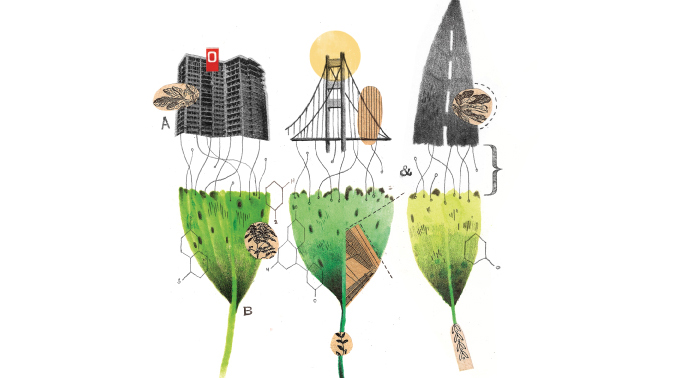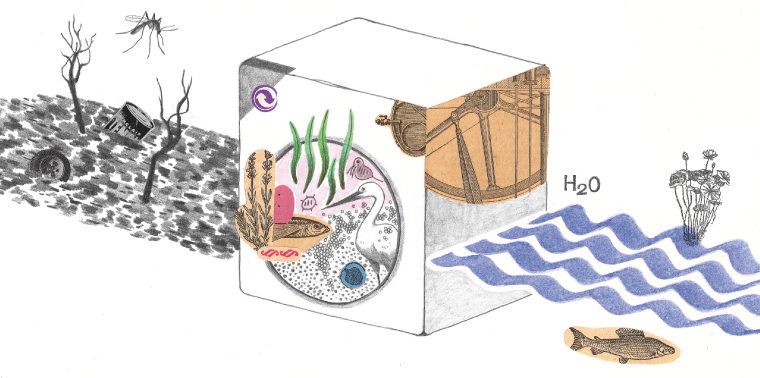January 29, 2013 — We humans are problem solvers. We’re doers. We encounter challenges and complicated situations and we find ways to surmount them—crafting tools, erecting bridges, programming computers. We’ve innovated and designed our way out of countless predicaments and, dammit, we will forevermore.
We are also hopelessly arrogant.
See, we humans sometimes forget that we are not the only innovators and designers out there. We’re not the only ones able to creatively adapt our way through tricky or threatening conditions. We forget about nature.
Long before we showed up on the scene, there were wetlands that made dirty water clean, prairies that grew sustainable food crops and termites that built living spaces capable of maintaining a nearly steady internal temperature year round. These and other natural systems, developed over thousands or millions of years, are amazingly adept at dealing with the sort of logistical concerns humans face every day—whereas many of the workarounds we’ve found for the problems of our lives are inefficient or overly expensive or carry on the oh-so-human tradition of causing more problems than they solve.
Luckily, we’ve also managed to learn that sometimes the best way to solve a problem is to borrow somebody else’s good idea.
Enter biomimicry—the idea of emulating strategies nature has perfected. By looking closely at natural processes and organisms, we can identify and learn from some of the ways nature solves the problems that challenge us. And the closer we look, the more of these solutions we find. Many of these nature-inspired solutions have implications for that most human of habitats: the city. From stronger building materials to more intuitive water systems, biomimicry has applications in urban infrastructure that can dramatically improve the way we live in cities.
Cities as Ecosystems
In her landmark 1997 book Biomimicry: Innovation Inspired by Nature, biologist Janine Benyus presents elegant examples of ways in which the natural world offers very clear hints about how to improve elements of our human world, such as how spider silk can inform the engineering of super-strong materials and how plants can teach us better ways to harvest energy from the sun. That book is now required reading for engineers, environmental scientists, industrial designers and practitioners of countless other disciplines.
“Nature is really a master example of making different things work one to the other and eliminating things that don’t fit with the picture.”
To spread these ideas into the real world, Benyus created a consulting firm now called Biomimicry 3.8—as in 3.8 billion years of research and design done for us already by nature. Biomimicry 3.8 biologists and designers work with groups and companies all over the world to try to inject some of the lessons of nature into their products and services. They’ve helped major apparel companies, airplane makers, hospitals and furniture designers.
The lessons of nature, Benyus says, apply widely across the spectrum. Even to entire cities.
“Actually, architects and city planners were the first audience to really embrace the book,” Benyus says.

Illustration by Samuel Castano
That might seem surprising at first. But in many ways, urban areas are like ecosystems. They have interconnected components such as buildings, streets and sewer systems that are themselves complex—like birds, orchids and insects all living within the framework of a tree. This sort of systems thinking is crucial for cities. Running cities that are efficient and equitable requires being able to see, for example, how water systems react to population growth or how the extent of a transportation network determines energy use and development patterns. Like nature, all these elements are connected.
More and more, biomimicry is being thought of as a way to reconsider the ways we build and operate cities.
“You don’t design a set of roads in isolation but in relation to buildings, but also to the sewer system below or to the cabling,” says Ilaria Mazzoleni, an architect and professor at the Southern California Institute of Architecture who’s been teaching and working with the concept of biomimicry in architecture for nearly 10 years. “There are a lot of invisible elements that go into it. And nature is really a master example of making different things work one to the other and eliminating things that don’t fit with the picture.”
Mazzoleni says this type of thinking is becoming more prevalent. True biomimicry, she argues, considers an object or building or infrastructure as part of a much larger system. Cities, therefore, are the perfect arena for biomimetic design. And given the vast amounts of aging and crumbling infrastructure in urban areas around the world, there’s plenty of work to be done.
More and more, biomimicry is being thought of as a way to reconsider the ways we build and operate cities. Today, these lessons are being actively applied in the realm of urban infrastructure and design in an effort to make places that are more sustainable, more livable, more intuitively designed and, at their core, more natural.
Lessons From Lavasa
To design roads the team looked to local anthills that are able to remain structurally sound during the region’s heavy rains.
About 60 miles (as the crow flies) southeast of Mumbai, India, the city of Lavasa is rising from the hills. With the guidance of Benyus and Biomimicry 3.8, Lavasa is being designed as a set of five small villages with populations between 30,000 and 50,000 people that will climb up the area’s steep slopes and mimic its dense forest. Benyus and her team have partnered with the architecture and planning firm HOK on the master plan for the second of the five villages, Mugaon. The plan and architecture are intended to create a sustainable framework for urban development in India, where the supply of housing is struggling to keep pace with the country’s swift urbanization.
Located in one of India’s monsoon hot spots, the hillside that will host Lavasa is subject to a short but intense rainy season that can see nearly 30 feet of rainfall in just three months, followed by months of drought. Despite all this water falling on steep hills, the area suffers almost no erosion and is able to use those water resources all year round.

Illustration by Samuel Castano
To understand how the hills stay intact, biologists from Biomimicry 3.8 studied the area’s ecosystem. Then they developed a set of “Genius of Place” design recommendations and ecological performance standards the city’s developers can use to ensure that whatever gets built performs at the same level as the natural environment. That means roofs that help re-release some of the monsoonal water back into the air as water vapor, pavement that allows water to permeate back into the ground and building foundations that grip the hillsides like the roots of trees. To design roads, for example, the team looked to local anthills that are able to remain structurally sound during the region’s heavy rains. The key, Benyus explains, is the anthills’ sinuosity, which channels and slows water as it runs over them. Lavasa’s roads are planned to mimic that characteristic.
Benyus and her team identified six “ecosystem services” provided by the area’s moist deciduous forest: water collection, solar gain, carbon sequestration, water filtration, evapotranspiration, and the cycling of nitrogen and phosphorus. Then they handed those to the planners and designers at HOK as guides for what their design would need to accomplish.
“They said in an ideal design solution, your new built environment would perform as if it were a moist deciduous forest,” says Mary Ann Lazarus, HOK’s director of sustainable design.
All Scales
Development in Lavasa has slowed recently due to some controversy over how the land was procured and how loans for construction were acquired, but Benyus says the model is sound. Biomimicry 3.8 is at work on similar projects in other places—especially China, where large-scale city building is occurring at an unprecedented rate. Biomimicry 3.8 and HOK, for example, drafted a master plan for Langfang, a city of about 4 million that’s part of the North China Plain’s Beijing-Tianjin mega-region. The plan seeks to counteract the drought and land subsidence the city has suffered due to unsustainable agriculture by implementing a wetland mimicry scenario.
Lazarus says HOK has integrated biomimetic thinking into its design work at all scales around the world. Some of the firm’s designers have even completed Biomimicry 3.8’s intense certification program on biomimicry thinking. In addition, they’ve developed a system of natural strategies based on each of 18 “biome regions” to guide projects when they can’t pull in the formal Biomimicry 3.8 team.
Even at the building scale, HOK is using the principles of biomimicry to improve design. One pro bono design, an orphanage in earthquake-ravaged Port-au-Prince, Haiti, used lessons from the local kapok tree to provide passive cooling, collect rainwater and mimic the tree’s protective bark for shielding the building from excessive heat. With no water, sewage or electrical connections, the building’s design is heavily reliant on these sort of natural systems. “It wasn’t like an aspirational goal,” Lazarus says. “It was like we have to have a closed-loop solution.”
Lazarus says that applying the lessons of nature to urban design and architecture has such obvious benefits that there’s no reason not to.
“In a way, I don’t consider it an urban issue or not an urban issue,” she says. “It works at all scales.”
Cleansing Power
Most often, infrastructural biomimicry happens at the smaller scale and with a focus on water. One of the most prominent examples is the Eco-Machine, a trademarked water treatment technique created by John Todd and his firm John Todd Ecological Design. Based on ideas that have evolved over the last three decades, the Eco-Machine is a type of constructed wetland that mimics the cleansing power of a marshland or estuary by combining plant life, aquatic tanks and various forms of living organisms to clean wastewater through a cycle of passive processes that doesn’t require any hazardous chemicals. By traveling into and out of a series of specialized tanks filled with specific plants, fish, zooplankton and bacteria, water is refined from polluted to clean. Eco-Machines have been used at a variety of scales to process water, from the sewage of office buildings to the groundwater of contaminated sites.

Illustration by Samuel Castano
One of Todd Ecological’s latest applications of the Eco-Machine technique takes on an intimidating problem. In Grafton, Mass., the firm is working with the site of a former mill on the Blackstone River. The mill burned down in the 1990s, and a new owner is hoping to turn the site into a small village. But along with the remnants of the mill are a series of buried storage tanks that have degraded over time, leaking a heavy oil known as Bunker C into a canal leading to the nearby river.
“Our results are showing over a 90 percent reduction of petroleum hydrocarbons within the system.”
Removing the tanks and the contaminated soil would be far too expensive for the site’s owner or probably any single person. So, with a grant from the U.S. Environmental Protection Agency, Todd Ecological was contracted to install an advanced version of its Eco-Machine that combines a floating system of plants and a biofilter within the canal to clean and draw water up to the system of tanks on the shore. The water cycles through the various tanks, and also a series of closed cells containing special fungi that perform even more intense cleansing before returning the water to the canal.
The system began operations in June 2012. Since then, the water has shown significant improvements. “Our results are showing over a 90 percent reduction of petroleum hydrocarbons within the system,” says Camron Adibi, a project manager at the firm.
“It cost the EPA $1 million to remove oil-contaminated sediment and took six months to dredge 300 feet of the canal,” Adibi says. “The Eco-Machine cost less than half this amount.”
Heal Thyself
Though water treatment is one of the most important functions of urban infrastructure, perhaps the most visible and ubiquitous example of urban infrastructure is concrete. From sidewalks to buildings to highway dividers to bridges, concrete is what our cities are made of. Though typically thought of as a blunt tool with a limited lifespan, concrete is actually becoming better and smarter. Researchers at the University of Michigan have been developing a new type of concrete that’s modeled on the self-healing properties of biological systems. Like human skin or the bark of a tree, this new concrete is able to fill in tiny surface fractures—essentially healing itself as it degrades. By absorbing moisture from the air, microfibers in the concrete slowly expand and harden, replacing cracks in the material with the material.
Far from being just a fancy trick, the nature-inspired ability to adjust to circumstances could save your life. Nearly 70,000 bridges across the U.S. are classified by the Federal Highway Administration as “structurally deficient”—two words it’s hard not to think about when you’re driving across a span of concrete over a 100-foot drop. While these bridges aren’t exactly crumbling beneath our tires, they are getting old and threatening to fail us in the most devastating of ways. Could nature inspire a better design next time? Researchers at the Swiss Federal Institute of Technology think so. They’re developing bio-inspired bridge designs that have the built-in ability to adapt to potential problems.
Using the structural principle of tensional integrity, or tensegrity, this bridge design is made up of two sets of components that are in either perfect tension or perfect compression. It’s a lightweight combination of struts and cables that is both strong and efficient. With the addition of sensors and actuators, tensegrity bridges can adapt their shape to account for the varying structural stresses of changing environments, such as wind or heat or particularly heavy loads, mimicking how nature stabilizes molecules, cells and even entire organisms. The result is a bridge that knows when its structure is being compromised and slightly rearranges its components to compensate—and stay standing.
Return on Investment
For Benyus and Biomimicry 3.8, applying the principles of biomimicry or even bio-inspiration to infrastructure and city problems is the future of design. More than half the world’s population now lives in urban areas; as that proportion grows, finding better ways to keep urban systems functioning will be even more important than it is today.
“When Category 5 hurricanes start coming up the East Coast every couple of years, that’s an indication that we need to get creative,” Benyus says.
Some people worry that transitioning to biomimetic infrastructure like engineered wetlands for water treatment is too cost-prohibitive to really work in urban areas. But Benyus rejects that concern outright.
“That’s a hackneyed excuse. It’s old. It no longer applies,” she says, arguing that there’s a clear return on these investments in terms of energy expenditures, water savings and the productivity of people. Continuing along the conventional path, she says, may be contributing to greater problems in the future. We need to look only as far back as the latest natural disaster to see how things can go wrong.
“When Category 5 hurricanes start coming up the East Coast every couple of years, that’s an indication that we need to get creative,” Benyus says.
And getting creative is one of those things we humans do so well. But we don’t have to do it all alone. Nature has already field-tested many of the solutions we need for the problems we face. If we only look, they’re not hard to find.
Ensia shares solutions-focused stories free of charge through our online magazine and partner media. That means audiences around the world have ready access to stories that can — and do — help them shape a better future. If you value our work, please show your support today.
Yes, I'll support Ensia!

Have read a tiny bit about bio-mimicry in the past, but nice to learn more about how it's developing in the here and now.
Thanks!
Dr. Korkmaz would be a great asset to get as a professor at a US University.
Another example of biomimetic thinking applied to urban planning is the emerging field of "urban metabolism" -- which looks at the flows of water, waste, and other nutrients through urban ecosystems. A great application of this approach is the design of Lloyd Crossing by Mithun Architects Designers + Planners, in which the design team compared flows of water, carbon, etc. against a "pre-development baseline."
My colleague Lyle Solla-Yates and I have also used this approach in our research, for instance investigating the impact of alternative waste management systems: http://www.carlsterner.com/research/2010_toward_the_green_city.shtml